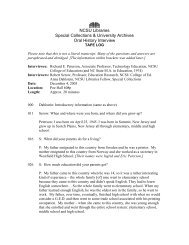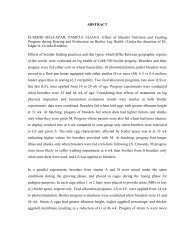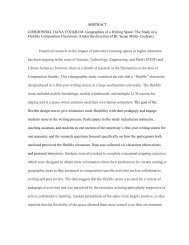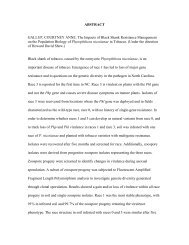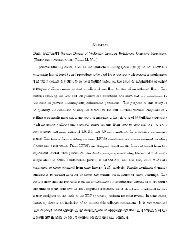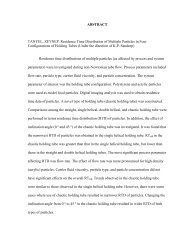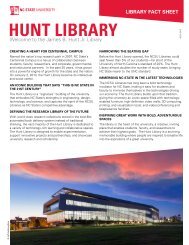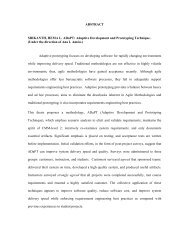SMITH, CHRISTINA JEAN. What Disappears and What Remains
SMITH, CHRISTINA JEAN. What Disappears and What Remains
SMITH, CHRISTINA JEAN. What Disappears and What Remains
Create successful ePaper yourself
Turn your PDF publications into a flip-book with our unique Google optimized e-Paper software.
us to forgive them their trespasses as they begin the process of building towards thenext nuclear holocaust - just as we are inclined to forgive Eve her bite of the temptingapple.For, with these Edenic parallels, Miller points out that Francis' innocence is no matchfor man's insatiable <strong>and</strong> innate curiosity <strong>and</strong> that these discoveries, at least that of the CircuitDesign, will eventually lead to the inescapable <strong>and</strong> onerous technological zenith point fromwhich Miller's characters cannot escape (per their place in Miller's deterministic, technoprimitivecycle which always builds towards destruction). But at the same time, Francis'adoration of the relic-blueprint <strong>and</strong> his subsequent labors to grace its reproduction with gold<strong>and</strong> floral designs do nothing to further man's movement toward a techno-zenith or tippingpoint. He does so only for the joy of artistically illuminating an object that so mystifies <strong>and</strong>delights him. Similarly, Brother Sarls toils over the algebra text because he finds joy inproblem solving <strong>and</strong> not because he will actually ever see the book translated <strong>and</strong> certainlynot because he would ever live to see its concepts put into practice. Miller uses thesepositive, uniquely human traits to highlight the double-edged beauty of man's capacity fordiscovery. Through these innocent child-men of Fiat Homo, he shows that ultimatedestruction begins with just a few endearing, toddler steps towards underst<strong>and</strong>ing the worldaround us (post-catastrophe). Thus these early character studies become a wry celebration ofhumanity in what is, largely, a grim allegory of societal failings. 1111 Judith Butler also sees Rachel, the second head of Mrs. Grales who appears to Zerchi in his dying moments at the end ofFiat Voluntas Tua, as a new incarnation of the "innocent" early man, Francis. "(Rachel)," she says, " represents innocence<strong>and</strong> the continuation of the human cycle of inncocence <strong>and</strong> free will, followed by the fall" (344). While Walker Percy saysthat the reader must ask him/herself "Who is Rachel? <strong>What</strong> is she?", <strong>and</strong> that their answer to that question will determinewhether or not the reader "got the book or missed it" (578). Perhaps Miller is using Rachel, at the end of the novel, as a signof hope that man has evolved into a new creature, one that is resistant to the effects of radiation <strong>and</strong> one that will avoid the21



